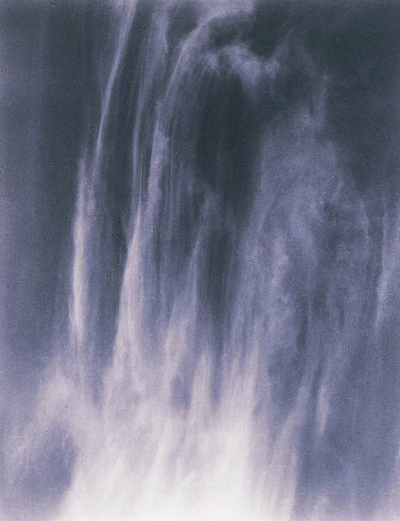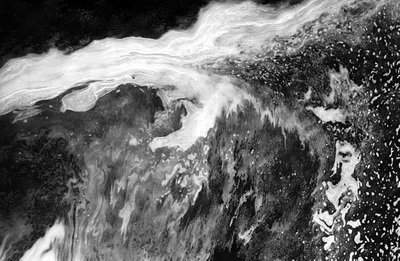

Alfred’s photograph was taken in 1925, it is of a dark blue sky with light clouds and was taken for Alfred’s project on ‘Equivalents’. The background is underexposed bringing the viewers attention primarily to the white, soft clouds. It uses natural lighting but evidently a low ISO has been used as there is a bit of a grainy texture to the dark, blue tones. The photographs creates an atmosphere of cold, neutral atmosphere due to the primary colour blue being used which emphasizes a wintry climate. The photographer has powerfully used the rule of thirds evidently situating the subject bottom center. It also creates this sense of the Divine due to the bright, white gleam coming through the clouds; a sort of sign from Above (literally).
In the second shot which was captured by Ernst Haas in Los Angeles around the 1950s. It is an abstract, black and white shot of soapy water with a variety of rich, black and white tones. By the “painting” effect in this image, the viewer can clearly see that the artist has used a slow shutter speed in order to capture movement and create this dreamy, abstract shot. The contrast between white and dark tones creates an illusion of the ocean; as if the picture was taken from above at the beach, these tones also suggest that the photographer has used artificial lighting to compose this image and make them fuller and richer. The way the picture is formatted gives the impression that this picture was taken from above with a still camera as the image is quite flat with no edges, and shows no signs of shake. Finally, both images have showed an understanding of depth of field as they are both close-ups of a specific subject.
In terms of similarities, both are digital images taken by a male photographer using a camera in the 20th Century. Both images portray a dream atmosphere and create a sense of simplicity and relaxation for the viewer through the use of light tones. These two images have powerfully explored dark and light tones and follow a repetitive patter. For example, Alfred’s follows a repetitive pattern with the clouds and Ernst’s follows a repetitive pattern with the soap both considered soft and fluffy subjects. These two shots clearly share similar focal points as the pair attempts to make the white, bright tones the main focal points of the images and the use of soft lighting to produce these outcomes.
Per contra, Alfred’s image has a wider variety of colours than Ernst’s as it is in colour as Ernst’s in in black and white. Nonetheless, Ernst Haas has created a photograph that looks more like a painting due to the slow shutter speed used and Alfred’s is in more detail and focus due to a faster shutter speed clearly being used which also creates a contrasting effect to Haas as it is more stroke and sharp. Evidently, they are both different images as one is of clouds and the other is of soapy water; Ernst’s contains harsher shadows and darker tones as compared to Alfred’s image that contains partially brighter tones, it also uses natural, dim lighting creating this “sign from above” feeling in comparison to Haas that most likely used artificial lighting to form this close-up – which is another difference because Alfred’s subjects are slightly further away from the “viewer” as compared to Haas who’s subjects are closer to the lens. Finally, the layout and size of them are different; Haas is a landscape rectangle whereas Alfred’s a portrait rectangle.
